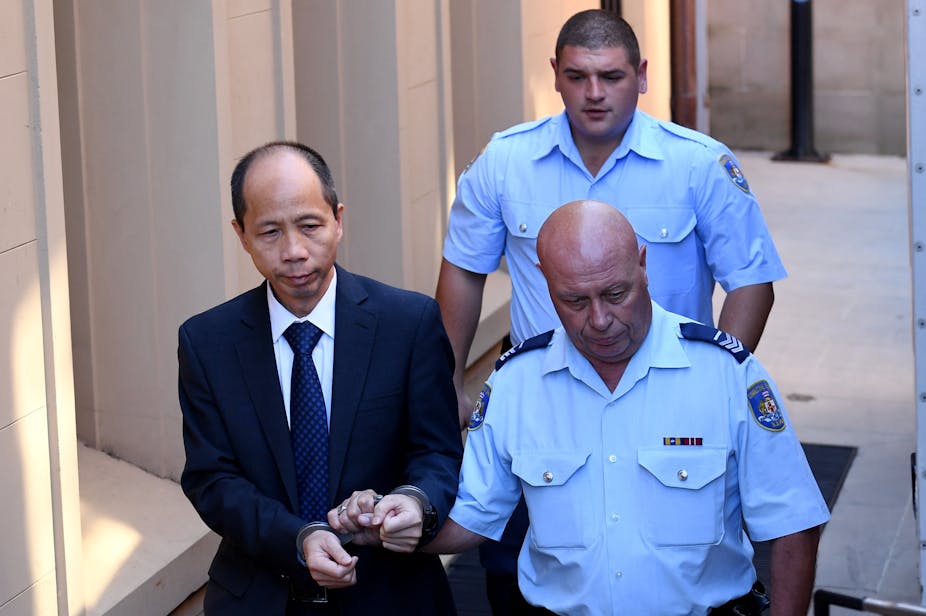A New South Wales man, Robert Xie, was sentenced to life imprisonment without parole last week for the horrific murders of five members of the Lin family.
Due to the shocking nature of the crime, Xie’s sentence has not attracted controversy. Yet NSW is the only jurisdiction in Australia that does not provide parole and review mechanisms for life sentences. This raises serious questions about whether such sentences are compatible with human rights.
The European Court of Human Rights has declared that a sentence of life imprisonment without the possibility of review is inhumane. Through legislative or judicial action, various European, South American and Scandinavian countries have abolished life imprisonment as unconstitutional or unfair.
In sentencing Xie, Justice Elizabeth Fullerton described the killings as “heinous in the extreme”, placing them in the worst category of case for murder. And it is difficult to imagine a more confronting set of facts.
Xie was found guilty of killing five members of his extended family in their home in the early morning. He used a “hammer-like weapon” with rope attached to “maximise the degree of assaultive force” following meticulous and calculated planning, likely motivated by jealousy.
But the shocking nature of these crimes should not obscure the problems inherent in sentences of life imprisonment. A stark aspect of the inequity and disproportion of a life sentence is the variable age of offenders when they are sentenced. Xie was 53 at sentencing and has a life expectancy of a further 33.1 years, having already served approximately five years in custody.
Much younger prisoners are being sentenced to life imprisonment. Vincent Stanford was only 24 when he was arrested for the brutal murder of Stephanie Scott in Leeton in 2015. His life expectancy was a further 61 years when he was sentenced to life imprisonment.
Roger Dean was 37, with a life expectancy of a further 48.3 years in 2013, when he received multiple life sentences for deliberately setting fire to the Quakers Hill Nursing Home and murdering 11 of the elderly residents.
In contrast, there are murder cases where lengthy maximum sentences have been imposed but it is difficult to clearly distinguish the gravity from the natural life cases. Adeel Khan was sentenced to 40 years’ imprisonment with a 30-year non-parole period after being convicted of three horrific killings, including an 11-month-old child, resulting from the arson of his shop.
And 31-year-old Craig Merritt, after initially being sentenced to life imprisonment for murdering his three young children, was re-sentenced on appeal in 2004 to determinate sentences totalling 34 years with a non-parole period of 27 years.
These examples highlight the disparity and inequity between different life-sentence prisoners, but also with those serving the longest determinate sentences for murder.
Since NSW introduced the natural life sentence in 1990, no identifiable litmus test has been formulated for deciding whether a particular murder falls within the worst category deserving of such a sentence.
The relevant legislative provision requires that the court must be satisfied that the level of culpability in the commission of the offences is so extreme that the community interest in retribution, punishment, community protection and deterrence can only be met by imposing a life sentence.
This provides general guidance and does little to ensure proportionate and equitable distribution of this most severe punishment. The law gives no indication of the weight to be apportioned to particular factors in determining when the threshold for a natural life sentence is reached.
The cases illustrate that there hasn’t been a consistent judicial approach to apportioning weight to these factors to reach reasonably proportionate and equitable outcomes.
In NSW, 41 prisoners are serving natural life sentences for murder. The killings range across a broad spectrum of seriousness. The offenders range from extremely dangerous to unlikely to kill again.
In fact, many studies have shown that homicide recidivism is very rare. One stark example is Phuong Ngo, who was convicted of being the contractor behind the first political assassination in NSW. This feature alone placed it in the worst category of case, even though Ngo had a strong subjective case and the sentencing judge remarked that a lengthy non-parole period would be fixed to the life sentence if that were possible.
In a recent international work on life imprisonment and human rights, the editors put the right to human dignity “at the core of all human rights potentially relevant to both the implementation and imposition of life sentences”.
The inequity and disproportion inherent in natural life sentences particularly infringes:
… the fundamental dignity-derived human right to be ‘rehabilitated’, in the sense of having the possibility of becoming full members of a free society.
It is important that the “re-educative” function of imprisonment be tested. Coupled with the fact that liberty is an important human right that should not be negated indefinitely by state punishment, it is time to seriously consider the continuing imposition of life sentences in Australia.
If it is to remain as the maximum sentence for murder, there must be a review mechanism in NSW to allow at least the prospect of release. The European Court of Human Rights has recognised this must be available to promote humane and equitable punishment of those convicted of even the most heinous offences.

